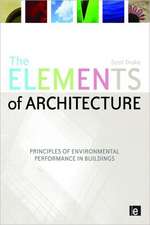Green Infrastructure: Incorporating Plants and Enhancing Biodiversity in Buildings and Urban Environments: Routledge Studies in Urban Ecology
Autor John W. Doveren Limba Engleză Paperback – 16 iul 2015
With more than half of the world's population now living in urban areas, it is vitally important that towns and cities are healthy places to live. The principal aim of this book is to synthesize the disparate literature on the use of vegetation in the built environment and its multifunctional benefits to humans. The author reviews issues such as: contact with wildlife and its immediate and long-term effects on psychological and physical wellbeing; the role of vegetation in removing health-damaging pollutants from the air; green roofs and green walls, which provide insulation, reduce energy use and decrease the carbon footprint of buildings; and structural vegetation such as street trees, providing shading and air circulation whilst also helping to stop flash-floods through surface drainage. Examples are used throughout to illustrate the practical use of vegetation to improve the urban environment and deliver ecosystem services.
Whilst the underlying theme is the value of biodiversity, the emphasis is less on existing high-value green spaces (such as nature reserves, parks and gardens), than on the sealed surfaces of urban areas (building surfaces, roads, car parks, plazas, etc.). The book shows how these, and the spaces they encapsulate, can be modified to meet current and future environmental challenges including climate change. The value of existing green space is also covered to provide a comprehensive textbook of international relevance.
| Toate formatele și edițiile | Preț | Express |
|---|---|---|
| Paperback (1) | 381.18 lei 6-8 săpt. | |
| Taylor & Francis – 16 iul 2015 | 381.18 lei 6-8 săpt. | |
| Hardback (1) | 1104.61 lei 6-8 săpt. | |
| Taylor & Francis – 24 iul 2015 | 1104.61 lei 6-8 săpt. |
Preț: 381.18 lei
Preț vechi: 483.41 lei
-21% Nou
72.96€ • 79.28$ • 61.33£
Carte tipărită la comandă
Livrare economică 21 aprilie-05 mai
Specificații
ISBN-10: 0415521246
Pagini: 352
Ilustrații: 48 black & white illustrations, 163 colour illustrations, 48 black & white tables, 161 colour illustrations, 22 colour line drawings
Dimensiuni: 174 x 246 x 15 mm
Greutate: 1.04 kg
Ediția:1
Editura: Taylor & Francis
Colecția Routledge
Seria Routledge Studies in Urban Ecology
Locul publicării:Oxford, United Kingdom
Public țintă
Professional and UndergraduateCuprins
Recenzii
"This is a very thoughtful, timely and comprehensive book. If our cities are to be considered as being truly sustainable then the integrated provision of green spaces will be a vital component of that sustainability. Green Infrastructure will help us to do just that." – Richard Sabin, Director, Living Green City, UK.
"This book is a useful addition to recognising key elements of urban ecology and what they can contribute" - David Walton, Bulletin of the British Ecological Society.
"Global in scope, pioneering in summarising the diverse concepts involved, encyclopedic in coverage, and modern, well-referenced and thought–provoking in its content, this clearly written text will become a classic as the psychological and physical health of urban people is progressively recognised as depending on their living environments. Numerous colour photographs and a variety of tables and diagrams enhance the text, and some 40 pages of references enable comprehensive further enquiry." - T.R. New, La Trobe University, Australia, in Journal of Insect Conservation (2016).
Descriere
With more than half of the world's population now living in urban areas, it is vitally important that towns and cities are healthy places to live. The principal aim of this book is to synthesize the disparate literature on the use of vegetation in the built environment and its multifunctional benefits to humans. The author reviews issues such as: contact with wildlife and its immediate and long-term effects on psychological and physical wellbeing; the role of vegetation in removing health-damaging pollutants from the air; green roofs and green walls, which provide insulation, reduce energy use and decrease the carbon footprint of buildings; and structural vegetation such as street trees, providing shading and air circulation whilst also helping to stop flash-floods through surface drainage. Examples are used throughout to illustrate the practical use of vegetation to improve the urban environment and deliver ecosystem services.
Whilst the underlying theme is the value of biodiversity, the emphasis is less on existing high-value green spaces (such as nature reserves, parks and gardens), than on the sealed surfaces of urban areas (building surfaces, roads, car parks, plazas, etc.). The book shows how these, and the spaces they encapsulate, can be modified to meet current and future environmental challenges including climate change. The value of existing green space is also covered to provide a comprehensive textbook of international relevance.

















